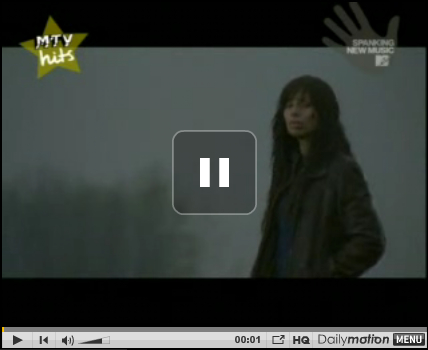This study has been very rewarding for me, personally. Setting out to investigate the different aspects of film that music video has adopted has undoubtedly heightened my awareness of the matter. It has been quite intriguing to pinpoint the different methods and techniques that have been utilized to benefit or forgo what viewers may expect from such promotional materials. As an aspiring filmmaker and music video director, this process has reinforced my understanding of what a narrative can look like and the different ways that Hollywood trends may benefit the commercial ventures in musical culture of today. Spanning a number of genres, locales and conventions (some more common than others), the eight music videos that have come to comprise this blog offer a fascinating look at cinema’s prevalent influence over music video.
Korn – “Freak On A Leash”
Posted in All Videos, Korn on May 9, 2009 by austintolinVodpod videos no longer available.
http://www.youtube.com/watch?v=fY_yjPvHQwY
Though it doesn’t express an overbearing influence from the innovative film, Korn’s “Freak on a Leash” certainly took note of The Matrix’s wildly popular visual effects in 1999. Released just months after the movie, the Jonathan Dayton and Valerie Faris collaboration was built around the concept of a bullet traveling from place to place, shattering objects in super slow motion. With a variety of cinematic touches, the mixed-medium, Grammy winner is a strong case for Hollywood’s ability to shape the style of music video.

Not surprisingly, the flying bullet is what viewers remember most about this now decade-old video. Helmed by Hydraulx, a visual effects company that has worked on recent big budget films such as X-Men Origins: Wolverine and The Curious Case of Benjamin Button (1), the CGI bullet is, naturally, a technique born out of popular cinema. Digital technology has allowed for great strides in the action genre, among others, increasing the trend of heightened reality that has brought a new stylization to violence. While the exact method of this particular production has not been disclosed, it is likely that a high-speed camera captured real-life action and a postproduction process rendered the bullet’s every move on screen. This approach would allow for such a surreal perspective of the relentless bullet in very life-like environments.

Occupying about the first minute and the final twenty seconds of the video are 2D animation sequences. While the inclusion of these portions is due largely to a growing interest in anime outside of Japan in the 1990s (2), films like Who Framed Roger Rabbit proved audiences could enjoy a product that isn’t limited to one individual aesthetic style. Created by comic artist Todd McFarlane, the animated images in “Freak On A Leash” exist to present action that might not have been as effective had they been shot with live actors. Such as with green screen techniques, this is yet another route that film is increasingly exploring when such opportunities are stylistically sound. Despite the live-action dominated landscapes with CGI, the video makes a smooth transition both out of and back into the hand-drawn medium that is reprehensible for the inciting incident.
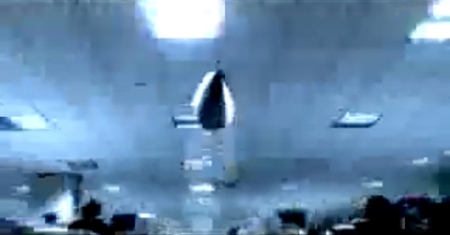
Adopting cinema’s traditional approach to time, the video operates in a very linear fashion. Beginning with the gunshot, the bullet soars past the young girl, through a wall and into a series of real world locations. Once it reaches the band in their performance space, it hovers for a bit and then immediately retreats along its initial path, back into the animated world. The editing style presents the action in a clear, chronological order that well serves the progression of events. It also showcases the impressive visual effects that place critical focus on the spectacle-inducing bullet.
This award winner for Best Music Video (Short Form) displays a keen sensibility for cinema’s latest pursuits. Though ten years have passed since its release, this video was certainly ahead of its peers and seems to have aged quite well.
Resources:
1 – Wikipedia.com
http://en.wikipedia.org/wiki/Hydraulx
2 – Wikipedia.com
http://en.wikipedia.org/wiki/Anime#Distribution
YouTube: http://www.youtube.com/watch?v=fY_yjPvHQwY
Will Smith – “Wild Wild West”
Posted in All Videos, Will Smith on March 27, 2009 by austintolin
Though many disapprove of the obvious borrowings from Stevie Wonder’s “I Wish” and the chorus from Kool Mo Dee’s own “Wild Wild West” (1) the 1999 title track from the movie Wild Wild West resulted in a product that illustrates a film’s direct responsibility for a music video.

Clearly on a mission to promote its summer blockbuster counterpart, the video for “Wild Wild West” exists in the same narrative universe as the film. Functioning as a “mini-sequel,” the video reveals itself to be a continuation of the narrative, taking place sometime after the events of the film (1). After introducing the crossover characters and announcing its inciting incident, the diegetic prologue ends when the camera sweeps across a desert landscape and arrives at singer Will Smith, who then initiates a familiar lip sync method. Spanning a variety of locales, including the town’s dusty main drag, a grandiose ballroom, and treacherous warehouse, Smith and his elaborate ensemble, dressed in western attire, carry out the source material-inspired performance in a convincing manner.

Embedded into one of the sets is a large composite backdrop that showcases clips from the movie. Seemingly obligated to enforce the tune’s “promotional theme song” status (1), the footage exists to build anticipation for the forthcoming film, at the time. Nevertheless, the images fit comfortably into this video’s landscape, from the nature of activity in the clips to the stylistic components of a clock on which they appear.

Obviously enough, the song’s main performer is none other than the film’s lead star, Will Smith. While it is not uncommon to witness the artist playing a non-musical role in music video, it is, however, a bit unique to find the artist reprising a fictional identity from another work. Considering his celebrity in both arenas, it was undoubtedly a clever marketing choice to blur the lines between Smith’s role as a rapper and his character from the referenced fictional film.
Without question, both the song and video were destined to be a hit for a handful of reasons. Whether or not one is willing to embrace such an overt marketing strategy, “Wild Wild West” is a highly efficient piece when considering the extreme nature of the film’s influence.
Resources:
Wikipedia.com
http://en.wikipedia.org/wiki/Wild_Wild_West#Soundtrack
Sigur Rós – “Glósóli”
Posted in All Videos, Sigur Rós on March 13, 2009 by austintolinHi-Quality Quicktime recommended: http://www.emichrysalis.co.uk/quicktime/sigur_ros/glosoli/index.php
If there is one thing fans of Sigur Rós can count on, it’s their commitment to present unique music videos, time after time. “Glósóli” is certainly no exception to their already impressive catalog. The utterly captivating vision from directors Stefan Arni and Siggi Kinski is a visually astonishing piece from beginning to end.

Among other things, one can’t help but appreciate the enchanting landscapes in this video. Such unfamiliar scenery, to the majority of viewers, is due to the locale’s general lack of exposure. “Drawn to extremes” and the “unlikely combinations that produce magical results,” Arni and Kinski found their home country of Iceland offered desirable locations that, in turn, would exude the band’s distinguishing heritage 1. Authentic location shooting is unquestionably a common practice in filmmaking. The opportunity to use an existing site is typically taken when either the location is readily available to use or when the location cannot be recreated in either a convincing or cost-effective manner. While the directors sought the terrains for their seemingly fantastical qualities, the spaces do maintain a sense of realism that alludes to their existence.

Thematically, “Glósóli” does articulate conventions of fantasy. From the adventurous band of children and their whimsical departure off the cliff, to the surreal, golden countryside, that may or may not be the product of a dream, this tale feels like an adventure that was crafted for the big screen. The climax, in particular, can be expected to evoke one cinema staple or another for viewers, whether it’s Disney’s classic Peter Pan or the Spielberg-directed E.T.: The Extra-Terrestrial 2. Who knows, maybe down the road “Glósóli,” despite its format, will be regarded with the level of recognition its generic counterparts have earned?

Aside from the visual effects near the end, this production was carried out pretty straightforward. With a mere “three days on 35mm with two anamorphic prime [lenses],” the crew worked only with “available light, a tripod and a few filters,” not to mention a cast of local child actors that included some nonprofessional 3. Aside from the very last shot in the video, every camera setup is restricted to physical ground, whether it’s a slow pan or handheld operation. It is likely that the video’s realism is linked in some part to the basic camera maneuvering. Furthermore, these strategies and their visual products read very much like the efforts of some independent films. Nevertheless, the resulting images could rival much of Hollywood’s endeavors, and perhaps claim superiority, in some cases.
Without a trace of the song’s performers, “Glósóli” demonstrates an aptitude to blur the line between music video and film. Whether or not its creators set out to prove any particular notion, it is certain that this extraordinarily cinematic work has played a role in drawing unlikely fans to the foreign sights and sounds of Sigur Rós.
Resources:
1 – ArniAndKinski.com
http://www.arniandkinski.com/bio
2 – Knight, David. “Made In Iceland.” Promo Magazine 15 Jan. 2006: 19.
http://www.arniandkinski.com/press/media/PromoJan2006.pdf
3 – Sigur-Ros.co.uk
http://www.sigur-ros.co.uk/band/disco/takk-Glósóli.php
YouTube: http://www.youtube.com/watch?v=lwQmDvuORY0
Hi-Quality Quicktime:
http://www.emichrysalis.co.uk/quicktime/sigur_ros/glosoli/index.php
Natalie Imbruglia – “Shiver”
Posted in All Videos, Natalie Imbruglia on March 7, 2009 by austintolinhttp://www.dailymotion.com/video/x1ti8_natalie-imbruglia-shiver
Jake Nava’s music video for “Shiver” by Natalie Imbruglia borrows a number of elements directly from The Bourne Supremacy (2004), as well as The Bourne Identity (2002). Recognizing the success of the budding franchise, Nava and Imbruglia took the opportunity in 2005 to embrace the action-oriented fashion in an effort to make a “departure from Imbruglia’s previous video styles” 1. It appears the idea was to place a female (Imbruglia) on the run, in the action-oriented circumstances usually reserved for males. With great consideration for the Bourne style, the final product offers intriguing visuals for a seemingly ordinary pop song.

“Shiver” faithfully achieves the look and feel of the Bourne films through mise en scène, a French term that means “the director’s control over what appears in the film frame” 2. Considering things such as “setting, lighting, costume, and the behavior of the figures,” Nava aimed to channel the tone and events of the films into this work 2. In some cases, such as the shot in the image above, Imbruglia was staged to closely match one of Jason Bourne’s situations. Additionally, consideration was given to details such as the street activity beyond the car’s cabin, as well as the raindrops on the window. Nava’s decision to shoot the video in Kiev, Ukraine during the winter offered the dreary climate that is often evident throughout the Bourne series. Such attention to detail was key to match the style of the films.
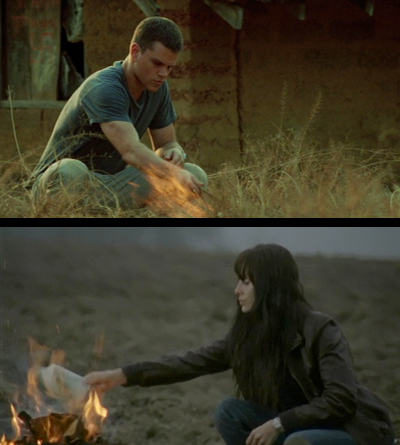
Plot is another aspect of the video that relies on established scenes from the Bourne series. The beginning of “Shiver” finds Imbruglia curiously burning her personal effects, implying someone is out to find and harm her. With the support of mise en scène, the series of shots draws an unmistakable connection between the two individuals and sets up familiar themes and events to come. Just after a minute into the video, Nava spells out the Bourne-inspired concept, for anyone with doubts, through a chase scene that features a car flying down a set of stairs. Both of these occurrences, supported by striking visual resemblance, were carefully selected from the source material to best identify the brand of the narrative.

Beyond the video’s well-defined, single inspiration is the potential to evoke other references. Whether it was Nava’s goal to do so or not, those who have seen the 1965 Italian film Red Desert might draw a visual connection to it through a shot in the second half of “Shiver.” In the scene following Imbruglia’s exit from a train, a wide shot consisting of a crowd of people, a row of cars, and an industrial site is awfully similar to a sight in Red Desert. While this particular music video is primed to admit motion picture references, it is certainly interesting to consider the medium’s power to allow for cinematic citations that may or may not have been intended.
This video’s obvious quotation of the Bourne films doesn’t grant the concept complete originality, but, overall, it is an effective example of a product of cinema. The ability to offer previously established material in a fresh venue is one of music video’s great debts to film.
Resources:
1 – iLoaded.com (2005)
http://www.iloaded.com/video/natalie-imbruglia-shiver-3860.html
2 – Bordwell, David and Kristin Thompson. Film Art. New York: McGraw-Hill, 2008. 112.
DailyMotion: http://www.dailymotion.com/video/x1ti8_natalie-imbruglia-shiver
YouTube: http://www.youtube.com/watch?v=XwfrwfReoz8
Bob Dylan – “Most Likely You Go Your Way (And I’ll Go Mine)” – Mark Ronson remix
Posted in All Videos, Bob Dylan on February 27, 2009 by austintolinhttp://myplay.com/videos/bob-dylan/most-likely-you-go-your-way-and-ill-go-mine
Mark Ronson’s remix of Bob Dylan’s “Most Likely You Go Your Way (And I’ll Go Mine)” was released as a bonus track on the 2007 box set, Dylan. The music video, directed by Rupert Jones, offers glimpses of the legend as he wanders through the past and on into the present. Interestingly enough, Dylan is played by a number of look-alikes to represent “the singer’s reputation for being elusive” 1. Utilizing a number of strategies to effectively capture each era, the end product serves as a highly cinematic celebration of Dylan’s illustrious career.

While I’m Not There (also released in 2007) offers a more complex look at the life of Bob Dylan, Jones’s video is a biopic of sorts, in its own right. Setting out to “show the expanse of Dylan’s art over the past five decades,” he was able to recreate many of the artist’s iconic moments with the intention of “accurately represent[ing] the style of those eras” 2. Realizing that the execution of his vision relied greatly on so many fine details, Jones called upon his stylist, Roger Burton, to gather props and wardrobes that would be faithful to history 2. With great consideration for each phase of Dylan, Jones and his crew were able to manufacture strikingly authentic accounts in the manners of a feature film.

The visual style is another ingredient that brings this striking concept to life. As each Dylan figure moves from one environment to another, the camera choice and format appears to change, albeit with tasteful transitions. Each resulting modification pairs the camera technology with its respective historical period, showcasing everything from Super 8 footage to a more extreme widescreen aspect ratio of Hollywood. Impressively, the production limited itself to the 16mm format and was able to manipulate the footage with post production color grading and effects to present each unique style 2. Such critical attention to mimicking the progression of cinema is a key part of this project’s success.

Finally, the concentrations of camera movement and editing complete this nostalgic recap of Dylan’s life. With the first account of him in the video, the camera follows from behind in a long take with the aid of Steadicam. This cleverly positioned shot avoids revealing Dylan’s face, a tactic that continues throughout the video. This instance is also one where adopting the long take method brings life to a familiar scene that resides on the album cover of The Freewheelin’. Much like Vanilla Sky’s intent to recall that moment with a twist, Jones does so from a new perspective with much due credit to the capabilities of motion picture.
Providing a fascinating journey through the years of Bob Dylan, this video is flooded with persuasion from cinema. A devoted attention to the visual tones of the medium enhances the believability of this consciously constructed series of memorable events.
Resources:
1 – CreativeMatch.co.uk (2007) http://www.creativematch.co.uk/viewnews/?94900
2 – StudioDaily.com (2007) http://www.studiodaily.com/main/searchlist/Defining-Decades-in-Bob-Dylan-Remix_8740.html
MyPlay: http://myplay.com/videos/bob-dylan/most-likely-you-go-your-way-and-ill-go-mine
YouTube: http://www.youtube.com/watch?v=oCeKkJlMJDQ
Additional Links:
http://stereogum.com/archives/stuck-inside-of-brooklyn-with-the-remix-blues-again_006144.html
Paul McCartney – “Dance Tonight”
Posted in All Videos, Paul McCartney on February 20, 2009 by austintolin
Michel Gondry has a reputation for bringing a unique and crafty touch to his work. It’s no surprise that Paul McCartney’s “Dance Tonight” from May 2007 is no exception. Full of melody and pleasing textures, the upbeat song stood with much potential to create an entertaining visual experience. Naturally, Gondry provided a vision from his dreamlike imagination that transcends that reality, as we know it.

The opening to the video is classically derived from cinema. In this case, the real world is established with a car driving in the country. With ambient sound of the outdoor scene in place, a bit of whistling is heard followed by dialogue of a gentleman. The camera soon adopts a perspective from inside the automobile and maintains a long take as a postman rambles on his way to making a delivery. When he knocks on the door of his destination he is immediately greeted by Paul McCartney. The two of them make their way to his dining table and clear a space for the curious package. McCartney opens it to discover an unexpected mandolin and, in explaining the curious gift to the postman, he begins playing the opening chords to the song. All at one, the music takes over and transforms the house into more than it seems. This precursor to the song takes a conventional approach to establishing a sense of narrative and allows an opportunity to set up the unusual events to come.

Technology plays a critical role in executing stories of fantasy in a convincing and compelling way. While there is little that modern visual effects are capable of, Gondry opted for a method more personally in tune with his style to capture the magic of cinema. As soon as McCartney begins playing the tune, “things take a distinctly dreamlike turn,” as ghostlike figures emerge from the same package in which the mandolin arrived 1. Making his way through his colorful home, McCartney is followed by the friendly figures as more arrive through the cupboards around him. The odd characters maintain a peculiar transparent quality and move playfully about the house. Such visual elements are made possible through a technique “based on smoke and mirror effects of magic tricks…and other early cinema effects” 2. The result allows McCartney and the figures to exist in the same physical space, providing an intriguing balance between a familiar domestic setting and a whimsical childhood fantasy.

Another aspect of the video that acknowledges cinema is the incorporation of recognizable talent. Depending upon your familiarity with the individuals, you may or may not recognize Mackenzie Crook (The Office, British television series) and Natalie Portmant (Closer, V For Vendetta). The final scene in the video also features director Michel Gondry playing drums at the party with Paul McCartney. The casting of name actors is a known custom to drawing audiences to see a film, and a cameo by the director is a wink to the filmgoers that directors such as Alfred Hitchcock were known for.
“Dance Tonight” is an exciting effort from Gondry. Using several components from cinema and a less popular approach to visual effects, this video effectively constructs an imaginative world in a fitting way.
Resources:
1 – SnapJudgement.com (2007).”Snap Judgment: Paul McCartney’s YouTube video premiere.” http://popwatch.ew.com/popwatch/2007/05/snap_judgement_.html
2 – Director-File.com (2007). “Paul McCartney – Dance Tonight.” http://www.director-file.com/gondry/mccartney.html
YouTube: http://www.youtube.com/watch?v=xTNXrkBSp_o
Quicktime: http://www.partizan.us/musicvideos/mg/sir%20paul%20mccartney%20%22dance%20tonight%22.mo
Richard Ashcroft – “A Song For The Lovers”
Posted in All Videos, Richard Ashcroft on February 13, 2009 by austintolin
Richard Ashcroft’s “A Song For The Lovers” is a not a usual venture for music video. Jonathan Glazer’s vision finds Ashcroft in a hotel room, where the song plays from a stereo, in a real-time narrative style. The nearly six-minute video avoids fast cutting, favoring the slow progression of a deliberate narrative that is commonplace in cinema. Ultimately, this patient method offers an unlikely payoff that works well for the song.

The plot itself feels very much like one of a short film, as it delivers a narrative in a concise way. In the first twenty-five seconds, the camera reveals a fluorescent light turning on and then proceeds to follow a man from behind who appears to have just gotten out of the shower. In a single take, the camera stays on the man until he sits on a bed, revealing that he is the song’s artist, Richard Ashcroft. Soon, he reaches for a remote to turn on the stereo, and, until this moment, this appears to be a familiar convention before the song’s arrival; this is, however, not the case. Existing in the same space as Ashcroft, the music plays over a stereo in the hotel room and continues as he meanders throughout the space, occasionally singing along. Finally, after following him through a number of idle motions, the fluorescent light in the bathroom flickers on suspiciously and soon catches his eye. After pausing the song, he slowly makes his way into the bathroom to examine the curious activity. **SPOILER** With suspense in the air, he arrives at the shower curtain and, after a brief pauses, proceeds to urinate into the toilet. With this unlikely reveal, this short narrative is brought to a close as the music fades out. The consideration given to Ashcroft’s activity is eminent, seemingly accounting for everything as it takes place continuously to the duration of the song. Such concern is very rare in the music video format.
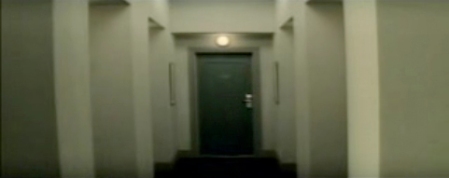
Sound functions very much like a film in this music video. Utilizing the “three components of the sound track—speech, music, and sound effects,” the video goes beyond an aural world that is limited to the song itself 1. While there is little dialog in the video, Ashcroft’s casual singing and mysterious phone call are undoubtedly evident and completely separate from the music. Every action is complete with a sound effect, from the light flickering at the beginning of the video to as the surprising moment near the end. These sound details further shape the atmosphere and tone of the video, just as a film would set out to do. And finally the music, “A Song For The Lovers,” plays an exceptional role within the narrative. Prompted by Ashcroft’s desire to turn on the stereo via remote control, the music begins at his hand and occasionally is paused when he feels the need. What’s interesting, as well, is that the volume and clarity change with the camera’s perspective and distance from the speakers in the room. It is only at the end of the video after a key moment that the music resumes non-diegetically, as a tag to bring the narrative to a close.

The visuals are also designed quite differently from most music videos. Shot with an anamorphic lens, the extremely narrow frame is quite common to cinema. Additionally, the wide shots and slower editing pace offer a clear view of the hotel room, thereby capitalizing on “the viewer’s mastery of the space” that is customary “in traditional Hollywood narrative” 2. With such long takes and attention to Ashcroft’s activity throughout the room, the overall look of the video adopts a very cinematic approach.
“A Song For The Lovers,” released in May 2000, is certainly not the first to construct a world where the image and sound revolve exclusively around the music, but it is very effective in incorporating the song into a concept that evades expectation.
Resources:
1 – Buhler, James and David Neumeyer. “Introduction to Part I.” Hearing The Movies: Music and Sound In Film History. New York: Oxford University Press, 2009: 4.
2 – Vernallis, Carol. Experiencing Music Video: Aesthetics and Cultural Context. Columbia University Press: New York, 2004: 213.
YouTube: http://www.youtube.com/watch?v=KNnh8nszFU0
Cold War Kids – “Hang Me Up To Dry”
Posted in All Videos, Cold War Kids on February 6, 2009 by austintolin
Vodpod videos no longer available.
If there is one music video that captures the qualities of film noir, it’s Cold War Kids’ “Hang Me Up To Dry.” Directed by The Malloys, this January 2007 release creates a harsh black and white narrative filled with deception and secrecy. Adopting a number of cinematic conventions, the video is a “striking reference to films of the past but features modern stylizing and art direction to give it an intriguing and ambiguous sense of time period.” 1 The final product presents itself as though it is a trailer for an actual film.

While music videos are often prone to montage editing to meet the demands of song structure and lyrical content, “Hang Me Up To Dry” takes this notion a step further to exist as a movie trailer operating with similar standards. What’s even more interesting is that this “trailer” is for a film that doesn’t even exist. Opening with a series of random images in sync with the song’s instrumental rhythm, the video builds up to revealing its identity as a trailer when the lyrics arrive with a title card for an assumed production. Appearing intermittently throughout the course of the video, onscreen texts range from film credits to story narration. Even critical reception is blatantly included in the form of text over a freeze frame. As it seems, the story of this non-existent film is about a romantic affair that causes a world of chaos unto its participants. Each succeeding shot in the video reveals something more about the conflict and the kinds of people involved, just as any Hollywood preview aims to.

The visual and narrative styles of the video are unmistakably derivative of film noir. Shot on black and white reversal film, the high contrast images define the tone of this dramatic tale. Even during moments of broad daylight, the mood is nothing short of intimidating. The disquieting affair at the center of the story questions the characters’ morals and leads to incidents of murder and conspiracy. The carefully chosen shots continuously speak to such thematic elements that are reminiscent of film noir. Finally, even after the lead male is gunned down by the sinister husband, a final moment finds him alive with his lover at his side, begging the audience to seek out the fate of all this mayhem. With so many convincing components in its favor, one can’t help but feel satisfied when the video concludes with a screen full of final credits, sealing its authentic spirit.
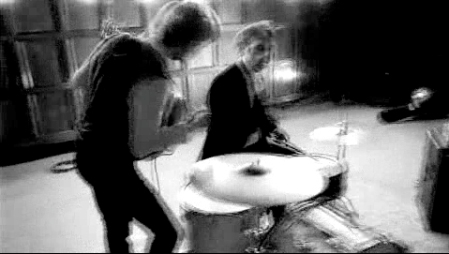
While it may not come as any surprise, the members of the band are featured in the video as characters as well as themselves during performance scenes. This strategy certainly isn’t groundbreaking, but for such an interrupting addition to the narrative the band fits in quite well. This is largely due to their attire that is consistent to a degree and the setting of the performance, which feels like a part of the narrative’s universe. Some liberty is taken in regards to style during performance shots. On occasion, frames seem to overlap or jump, providing an altered sense of motion. Fortunately, this technique seems to fit well with the video’s conscious respect to film history, such as the days of silent film when frame rates were likely to vary.
“Hang Me Up To Dry” is successful on a number of levels. Taking great strides in technical achievement, it borrows heavily from film techniques and methods to create an authentic tribute, while providing a unique promotion for the artist. This is certainly a memorable video.
Resources:
1 – EverythingRock.com (2007). “New Cold War Kids video.” http://www.everythingrock.com/article/3509
Streaming Video: http://www.revver.com/video/150577/4144/
Quicktime: http://media.revver.com/qt;download/150577.mov
